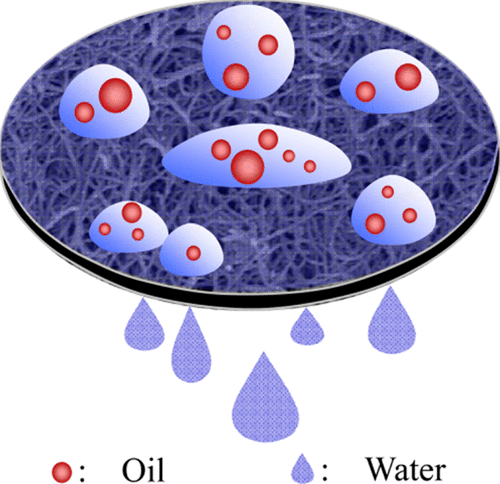Our official English website, www.x-mol.net, welcomes your
feedback! (Note: you will need to create a separate account there.)
Development of Highly Efficient Oil–Water Separation Carbon Nanotube Membranes with Stimuli-Switchable Fluxes
ACS Omega ( IF 3.7 ) Pub Date : 2018-06-20 00:00:00 , DOI: 10.1021/acsomega.8b00641 Junwen Hu 1 , Xuefeng Li 1 , Jinfeng Dong 1
ACS Omega ( IF 3.7 ) Pub Date : 2018-06-20 00:00:00 , DOI: 10.1021/acsomega.8b00641 Junwen Hu 1 , Xuefeng Li 1 , Jinfeng Dong 1
Affiliation

|
In this work, a carbon nanotube (CNT)-based membrane [(4-((4-((11-ferroceneundecyl)oxy)phenyl)diazenyl)phenoxy)-diethylene triamine (FADETA)/polyethyleneimine (PEI)-decorated CNT membrane] with stimuli-switchable separation fluxes was developed. The multiwalled CNTs were modified by a pH-, light-, and redox stimuli-responsive surfactant FADETA initially, and then the FADETA-decorated CNTs were further cross-linked by PEI and finally coated on the polypropylene membrane. Interestingly, the particular membrane was successfully applied in emulsion systems to separate oil and water with high efficiency. First, the FADETA-/PEI-decorated CNT membrane showed highly porous microstructural characteristics owing to the overlapped and cross-linked CNTs as confirmed by the scanning electron microscopy observation. Then, it showed strong hydrophilicity to water in the air and high oleophobicity to oil underwater, thereby endowing the membrane with the potential to separate oil and water. Owing to the modified multiple stimuli-responsive FADETA on CNTs, the separation fluxes were stimuli-switchable, which could be adjusted reversibly by environmental factors including pH, light, and redox.
中文翻译:

具有刺激可切换通量的高效油水分离碳纳米管膜的开发
在这项工作中,基于碳纳米管(CNT)的膜[(4-((4-((11-二茂铁十一烷基)氧基)苯基)二氮烯基)苯氧基)-二乙烯三胺(FADETA)/聚乙烯亚胺(PEI)装饰的CNT膜] 开发了具有刺激可切换的分离通量。多壁碳纳米管首先通过pH、光和氧化还原刺激响应的表面活性剂FADETA进行修饰,然后FADETA修饰的碳纳米管通过PEI进一步交联,最后涂覆在聚丙烯膜上。有趣的是,这种特殊的膜已成功应用于乳化系统中,以高效分离油和水。首先,扫描电子显微镜观察证实,由于碳纳米管的重叠和交联,FADETA-/PEI 装饰的碳纳米管膜表现出高度多孔的微结构特征。然后,它对空气中的水表现出强亲水性,对水下的油表现出高疏油性,从而赋予膜分离油和水的潜力。由于碳纳米管上经过修饰的多重刺激响应 FADETA,分离通量是可刺激切换的,可以通过 pH、光和氧化还原等环境因素进行可逆调节。
更新日期:2018-06-20
中文翻译:

具有刺激可切换通量的高效油水分离碳纳米管膜的开发
在这项工作中,基于碳纳米管(CNT)的膜[(4-((4-((11-二茂铁十一烷基)氧基)苯基)二氮烯基)苯氧基)-二乙烯三胺(FADETA)/聚乙烯亚胺(PEI)装饰的CNT膜] 开发了具有刺激可切换的分离通量。多壁碳纳米管首先通过pH、光和氧化还原刺激响应的表面活性剂FADETA进行修饰,然后FADETA修饰的碳纳米管通过PEI进一步交联,最后涂覆在聚丙烯膜上。有趣的是,这种特殊的膜已成功应用于乳化系统中,以高效分离油和水。首先,扫描电子显微镜观察证实,由于碳纳米管的重叠和交联,FADETA-/PEI 装饰的碳纳米管膜表现出高度多孔的微结构特征。然后,它对空气中的水表现出强亲水性,对水下的油表现出高疏油性,从而赋予膜分离油和水的潜力。由于碳纳米管上经过修饰的多重刺激响应 FADETA,分离通量是可刺激切换的,可以通过 pH、光和氧化还原等环境因素进行可逆调节。











































 京公网安备 11010802027423号
京公网安备 11010802027423号